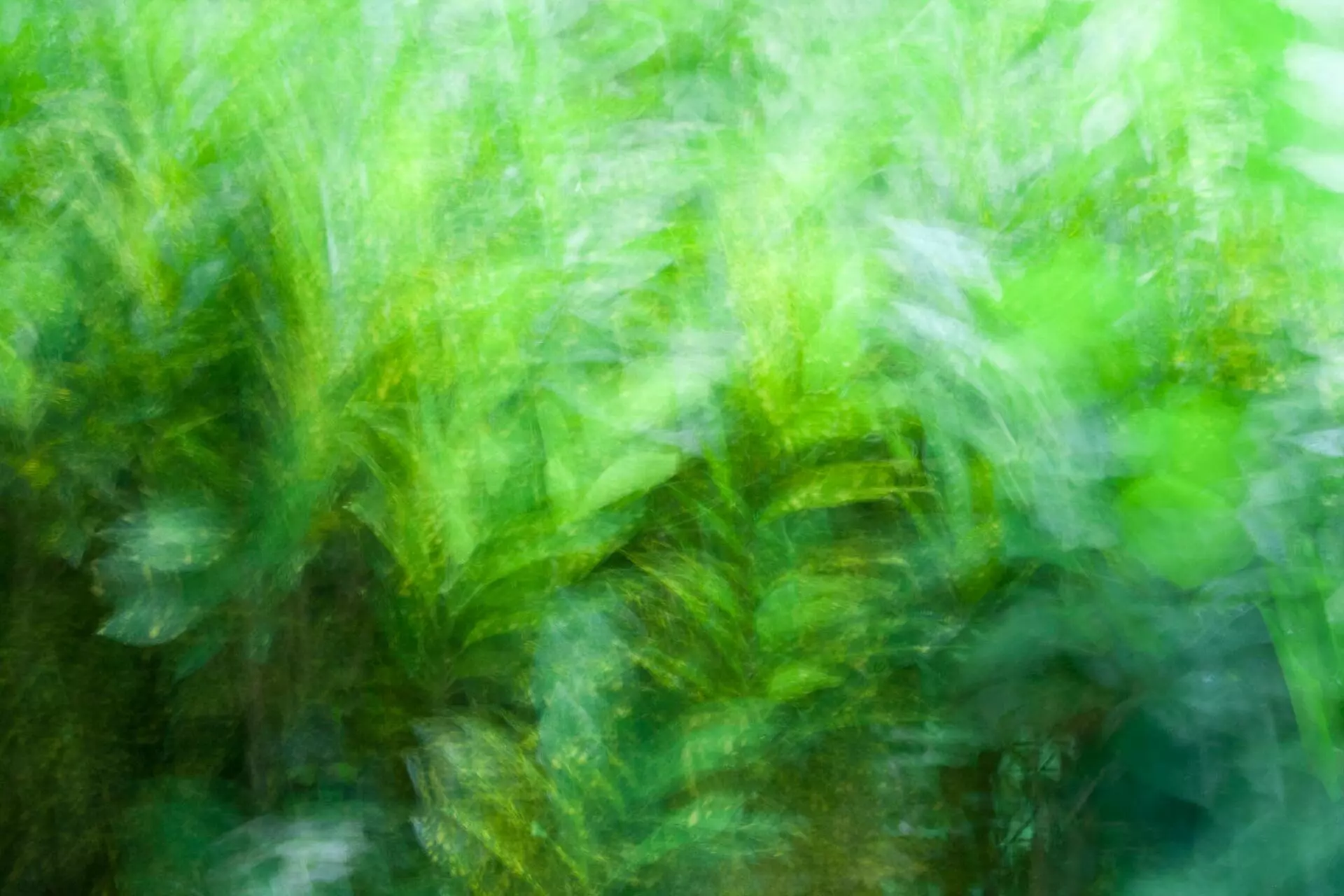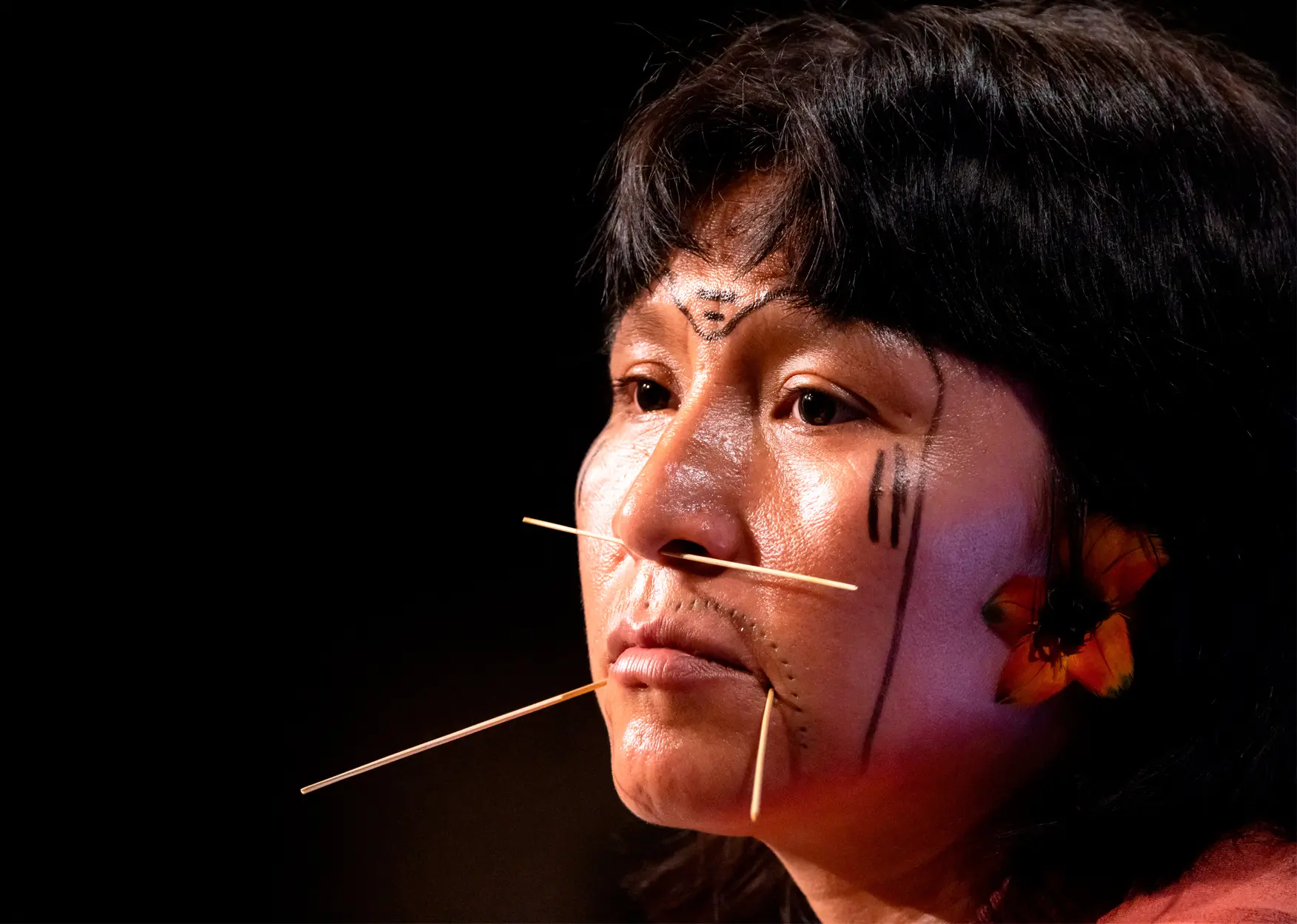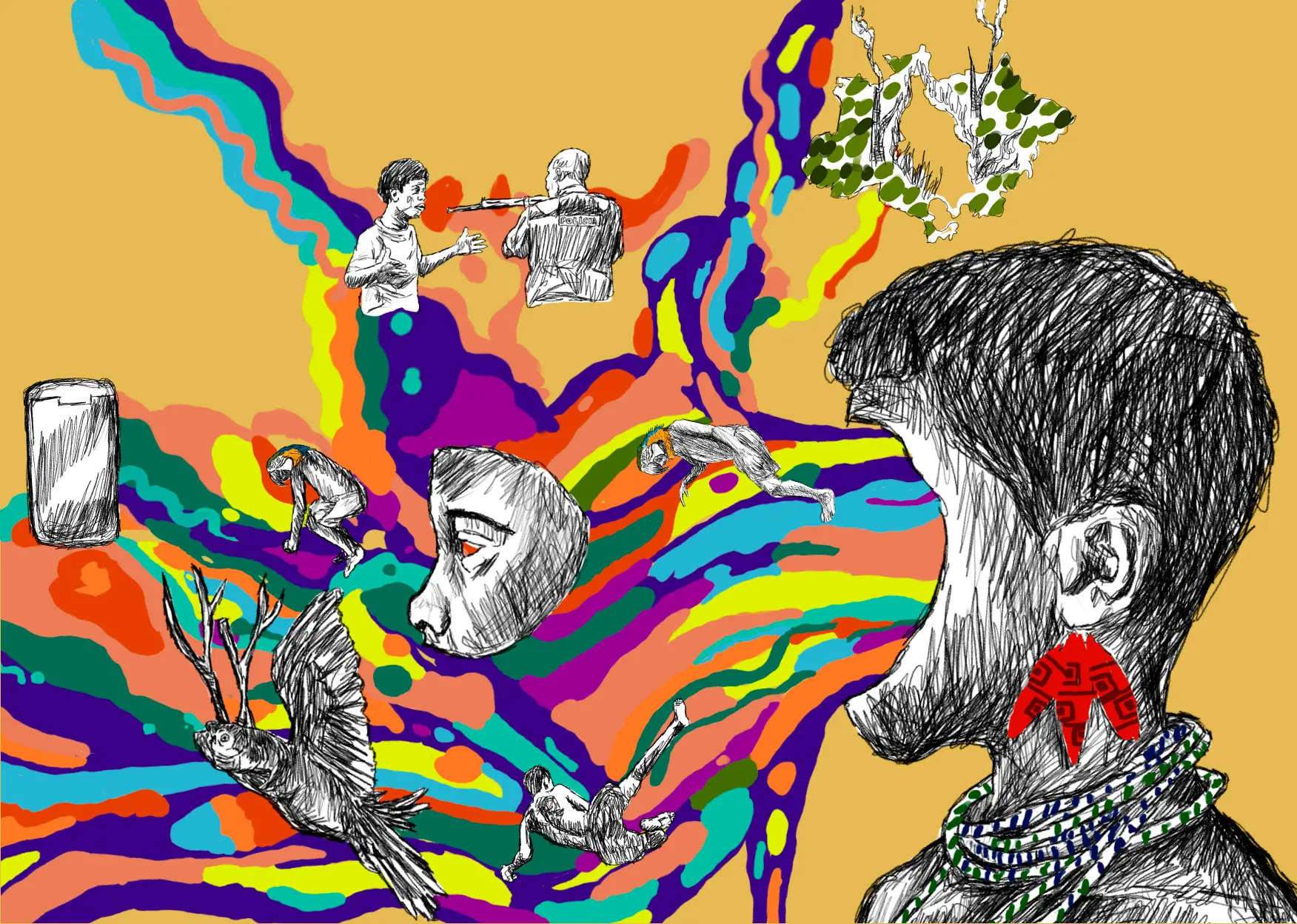As the Chilean poet Nicanor Parra said, “We think we are a country, when we are barely even a landscape.” This is the phrase we’ve had to try to get away from, and which we experience all over. In the West Indian Caribbean in a very concrete and piratical way, in the colonial Caribbean in post-colonial times, it is felt on the skin, in the lungs, in the mouth. Bodies and landscapes, as always, are the same thing.
Beauty first. I am ten years old. I am in the science club at school, and they take us on a field trip to the bioluminescent bay of La Parguera, in the town of Lajas in southern Puerto Rico. Everything is more Caribbean in the south; the sea is much clearer than the marine blue of the Atlantic that bathes the north of the island. In the south it’s warmer, everything is more… Caribbean. The warning is necessary. In this story, skin will change color and seawater will glow in the dark. The land will also emit light. The true magic of the Caribbean, that is the other phrase. The beauty of the cliché is its origin, and its inescapable sadness is its literalness.
Most of us are children from the center of the country. We live around the Cordillera Central or the Sierra de Cayey and when we are teenagers we will escape to the river, or the lechoneras to eat roasted pork, but rarely to the beach. But on this day, we are still children, and we are heading south to jump into the water at night.
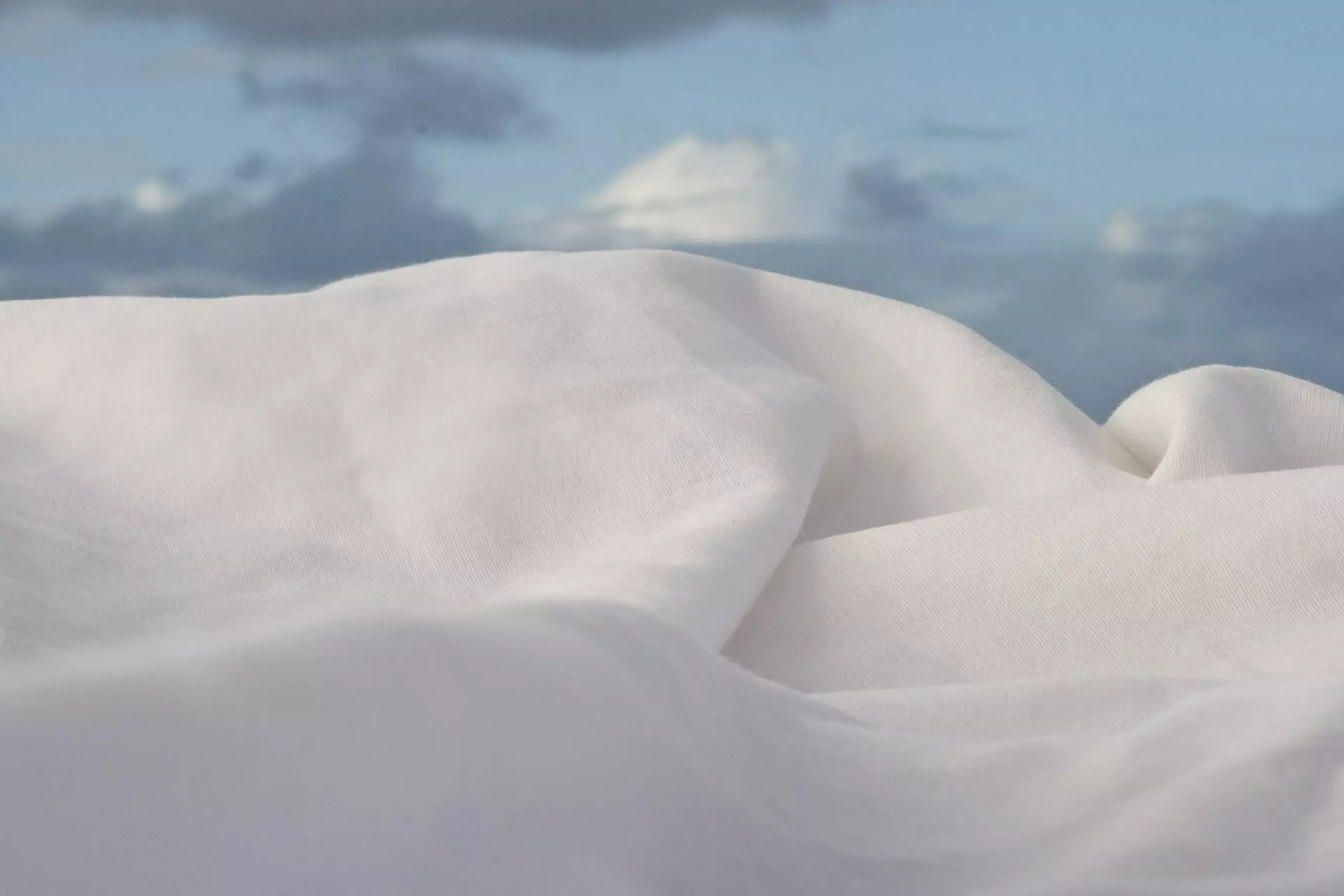
It has been almost thirty years since that trip, and the memory of going in the small boat and jumping into the water —with something more like anticipation than fear— is still fresh and clear in our minds. The dark salty water that shone in luminous shades of bright green had something to teach us. We swam. We moved our hands and, as our arms dipped in and out of the water, a sheet of light and a tickling sensation moved across our fingers, wrists, elbows, over all our skin. We laughed the way people laugh when they don’t quite understand where the pleasure they are experiencing comes from. We laughed the way people laugh when they surrender to beauty, to the nervousness of being in its presence. The bioluminescent bay tried to explain some of these mysteries.
There are only a handful of bioluminescent bays in the world. In Puerto Rico there are three of them: Puerto Mosquito Bay in Vieques, Laguna Grande in Fajardo and La Parguera. In Japan there are also some, one of them, Toyama Bay, is known as the “sea of stars”. Precise. Accurate. The blue-green light comes from microscopic single-celled organisms, a species of dinoflagellates that, when agitated and grown in large enough numbers, produce a luminous or glow-in-the-dark effect, creating a unique ecosystem. In the Caribbean, in addition to the Puerto Rican ones, there is one in St. Croix, one in Jamaica and one in the Cayman Islands. The brilliance indicates the health of the ecosystem.
For decades there have been warnings about the delicate nature of these ecosystems, and the importance of their preservation, for the health of the environment on a large scale. Their stability is not only indicative of water quality, swell levels, oxygen levels, acidity, salinity and water temperatures; it is also part of an extensive —and often invisible— food chain that nourishes the environment. For example, organisms that generate it use it as camouflage, as a defense tool or even for the opposite effect, to attract prey. It is therefore a form of communication in itself. At the same time, it is an area of science with ample scope for study and exploration. But perhaps its most coveted or appreciated quality, apart from its rarity in the wide diversity of ecosystems on the planet, is that it blends science with humanistic values. Thus moving away from the implicit separation of scientific knowledge and ethical, spiritual and aesthetic evaluations that happened from the time of Rene Descartes, through the Industrial Revolution and Charles Darwin. Although in the past people entered the sciences as a devotional act of appreciation of God’s work, this is no longer possible. However, when witnessing the luminosity of a bay of this nature, if one does not evoke some religious creed, one can at least invoke poetry. In other words, their existence and preservation is also a humanist emergency.
In numerous interviews over the course of an extensive career specializing in and researching bioluminescence, marine biology researcher at the University of California and its Scripps Institution of Oceanography, Michael Latz has acknowledged Puerto Rico’s uniqueness globally when it comes to this phenomenon. This is because it has the largest number of permanent bioluminescent bays in the world. In other words, they shine all year round. But, although their value has been celebrated, there have been warnings about how waste fuels from boat engines, sewage discharged from boats anchoring there and sedimentation affect the health of the ecosystem. As is often the case with this type of attraction: tourism taken to massive levels, i.e. human presence —both physical and through the use of transport and machinery— affects the conditions that need to exist for these organisms to manifest themselves naturally. The balance between access, enjoyment and stability is evident here, as in virtually all protected areas around the world. In the case of these areas, they are under the parameters of protected zones established by the US government. We will go into more detail on this later.
Periodically, over time, the bays have lost and regained their luminosity, but there has never been a general blackout —in every sense of the word— like the one experienced after Hurricane Maria hit the country in 2017. The main one —Puerto Mosquito on the island municipality of Vieques— was left in total darkness. The damage to the mangrove, so fundamental to the food chain of light-producing organisms, was massive. For months the bay did not shine, but nature’s regenerative capacity combined with the efforts of experts who rescued the area, led to the light coming back. The incandescent greenery of the island foliage also returned, having disappeared from the landscape the morning after the hurricane, revealing impoverished communities that had been hidden from the eyes of the privileged beneath the shadow of the immense island greenery. As always, all beauty has its dark side.
***

The light returned to the water before it returned to the land where the 3.3 million inhabitants of the island —which has experienced major migration in the 21st century, reducing its population from 4 million— remained without access to electricity for months, some for more than a year. The concrete consequences of the precarious management of the emergency are most cruelly calculated: in terms of human life. The strongest study, conducted by Harvard University, estimated 4,645 deaths linked to the disaster. Prior to the publication of this and similar studies, the government insisted there were 64 deaths in the aftermath of the hurricane, despite the fact that local media such as the Center for Investigative Journalism, with immense difficulty, traveled around the island and managed to estimate the figure at approximately 1,000 immediate deaths. Funeral homes were overwhelmed; people buried relatives in their backyards.
According to the valuable research by this prestigious university —which gave it a real and forceful place in the national conversation— most of the deaths had to do with the interruption of health services for the elderly and the immense failures in public health services for the chronically ill (dialysis patients, cancer patients and so on) due to an absence of electricity and diesel to run power plants, as well as damage to the health infrastructure.
One example of vocabulary is enough. In those days we discovered, as a country, the definition of the word leptospirosis. The bacterial infection that had affected the waters was being talked about everywhere. People were dying because of it. We were dying because of causes whose definitions were new to the national debate. When a country learns a new vocabulary to narrate its reality, it is because it has irremediably changed its foundations.
In Puerto Rico, as anywhere else in the world, when we talk about light, we talk about life. And when alluding to the ability to protect the light —the light of the greenery, the light of the waters, the light that allows a hospital to function— it is inevitable to fall into the Puerto Rican centrifuge, the great national obsession, Puerto Rico’s status as a State, Free, Associated of the United States. This is an oxymoron —a colonial euphemism in the post-colonial era— that affects the smallest aspects of the existence of the island’s inhabitants and its immense diaspora. And, above all, it has far-reaching implications for the ability to defend and protect the land: the ideological (that which pertains to narrative and imagination) and the material, with its remarkable diversity of natural resources.
It’s hard to write about the same thing. It’s a subject that has been written about in the newspapers since the US military occupation in 1898, as a result of the Spanish-American War, in which the island was given as booty by Spain to the United States. It is tiresome to type about the same thing, especially in recent times, when Puerto Rico has garnered some interest again in the international public sphere because of the constant natural —as well as economic and political— disasters it has had to face over a very short time period.
The bankruptcy of the Puerto Rican government can be traced back a long way, but a key turning point was 2006, when a government shutdown had to be ordered due to the precarious state of the public coffers. Three main causes must be highlighted. Firstly, the culture of public corruption on the island. Secondly, the fact that Puerto Rico was an economic experiment in expansion, not development. In other words, the island’s economy was built on the foundations of a project of tax exemptions mainly for pharmaceuticals, and when that project ended, there was no substitute economic plan, and the country was left in limbo. And finally, and most important of all, is the obvious fact that Puerto Rico is living an anachronistic colonial existence. It is impossible to build on what is owned at all levels except state and political.
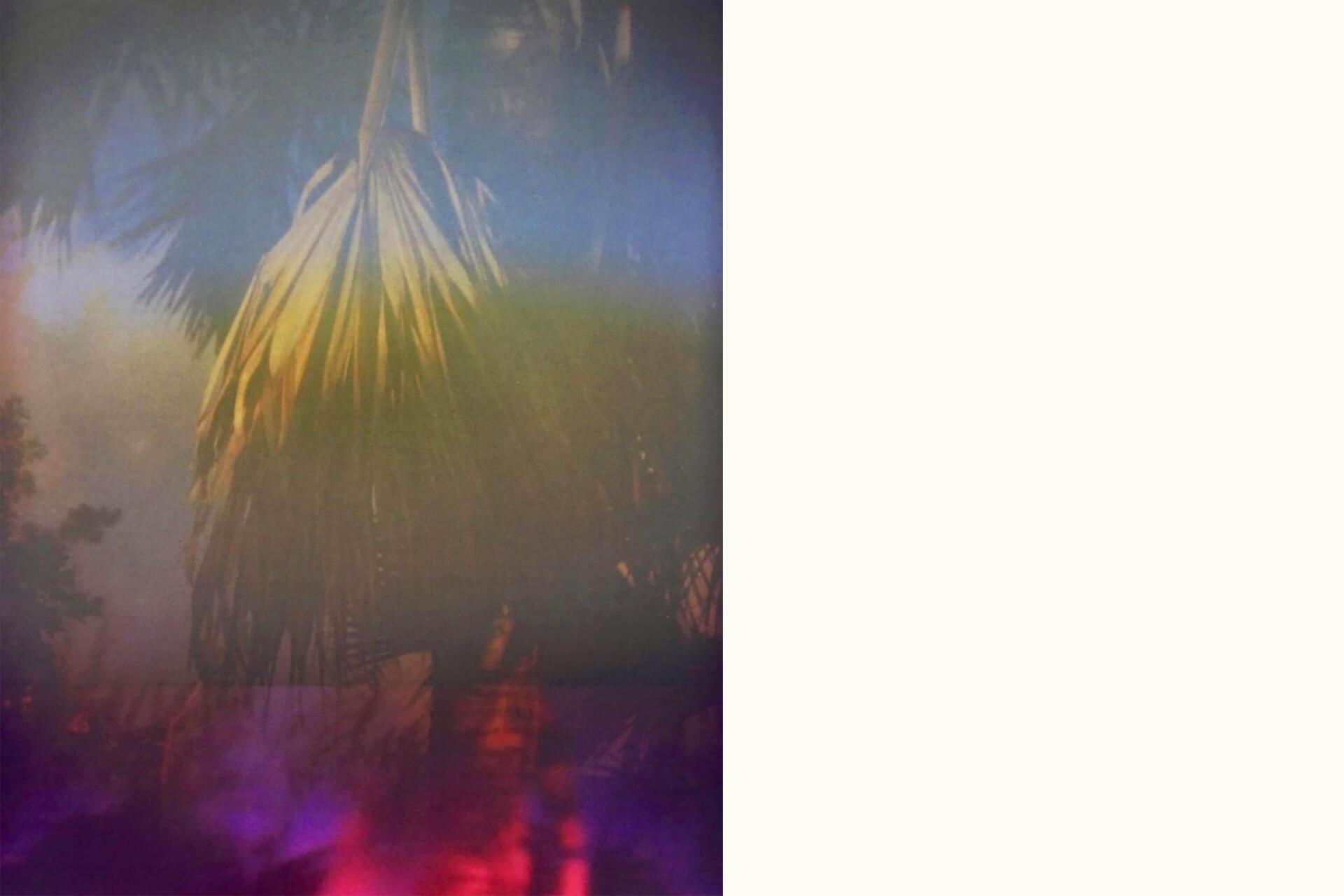
The shutdown occurred two years before the major economic crisis that triggered the housing bubble in the United States in 2008. The deterioration was escalating and by 2016 the metropolis imposed a Financial Oversight & Management Board that has determined the path of fiscal recovery, placing the interests of the bondholders affected by the fall of the island’s economy far above the interests of the citizens.
A year later, two hurricanes, Irma and Maria, further fractured the country’s already battered psyche and economy. And the hurricane winds had not yet finished blowing when The Battle for Paradise began, as the book on Puerto Rico and disaster capitalism, published in 2018 by journalist Naomi Klein, renowned for her analysis and research on the shock doctrine and the way it operates for the piratical plundering of entire countries and regions, is called. This, coupled with the contempt with which the administration of the then president Donald Trump reacted to the crisis, turned the country into a political football in the deep polarization that the United States is experiencing politically and socially.
On his post-hurricane visit to the country, President Trump attended a photo opportunity typical of such visits. The classic photo of the president handing out aid. He was taken to a community to hand out basic necessities to an audience that projected fanaticism rather than need. The image of the president throwing rolls of paper towel into the crowd went viral. And if only it had been just that, but the laxity in sending and authorizing aid —to which the island is entitled as it pays for it in countless ways— was the clear signal of US policy: this island is a big spender, an uncomfortable pleasure. As always, no one has been willing to pay what it costs for paradise.
It is well known that the Antillean Caribbean has been treated throughout history as a kind of laboratory in which more than one empire has tested political, economic and environmental projects that have defined the region’s history with global consequences. It was in Puerto Rico, for example, that they experimented with the contraceptive pill, making countless women infertile without their consent; women who never knew that their future was part of an experiment. Their bodies, as always, disposable, valuable only insofar as they have been able to be used. Hence, the euphoria provoked by the disaster in the coffers of those who market words like resilience and rehabilitation, did not come as a surprise. In the wake of the hurricane, the invasion of non-profit organizations and foundations has been monumental, selling the country as a tax haven for Cryptopians is going from strength to strength. Setting up for next to nothing, working in paradise for six months — which nobody really documents— making millions and investing very little in return… This is the new pied piper’s flute. The mice live here as always. Uncomfortable, chasing the music that leads nowhere.
“Central to a shock doctrine strategy is speed — pushing a flurry of radical changes through so quickly it’s virtually impossible to keep up….. Capital is fast”, Klein explains, or warns, throughout her book, in which she also concentrates on shedding light on the voices of various community groups, or islands of sovereignty as she calls them, who are resisting —in an organized way and with the defense of natural resources as their main focus of action—, this piratical onslaught that increasing numbers of people are now recognizing as displacement and even as a second occupation. The juicy tax exemptions, the disproportionate sale of land and buildings to representatives of big business— both from the United States and other countries—, the encouragement of migration in the face of the precariousness of essential services (health, education, energy —here it is rare not to have blackouts— and security, among others) are the current situation in the country six years after the environmental disaster. A weather event that has also served as a warning to the world that this will be the norm from now on. More disasters, more frequent and more devastating. Once again the Antillean Caribbean acts as a mirror for the world.
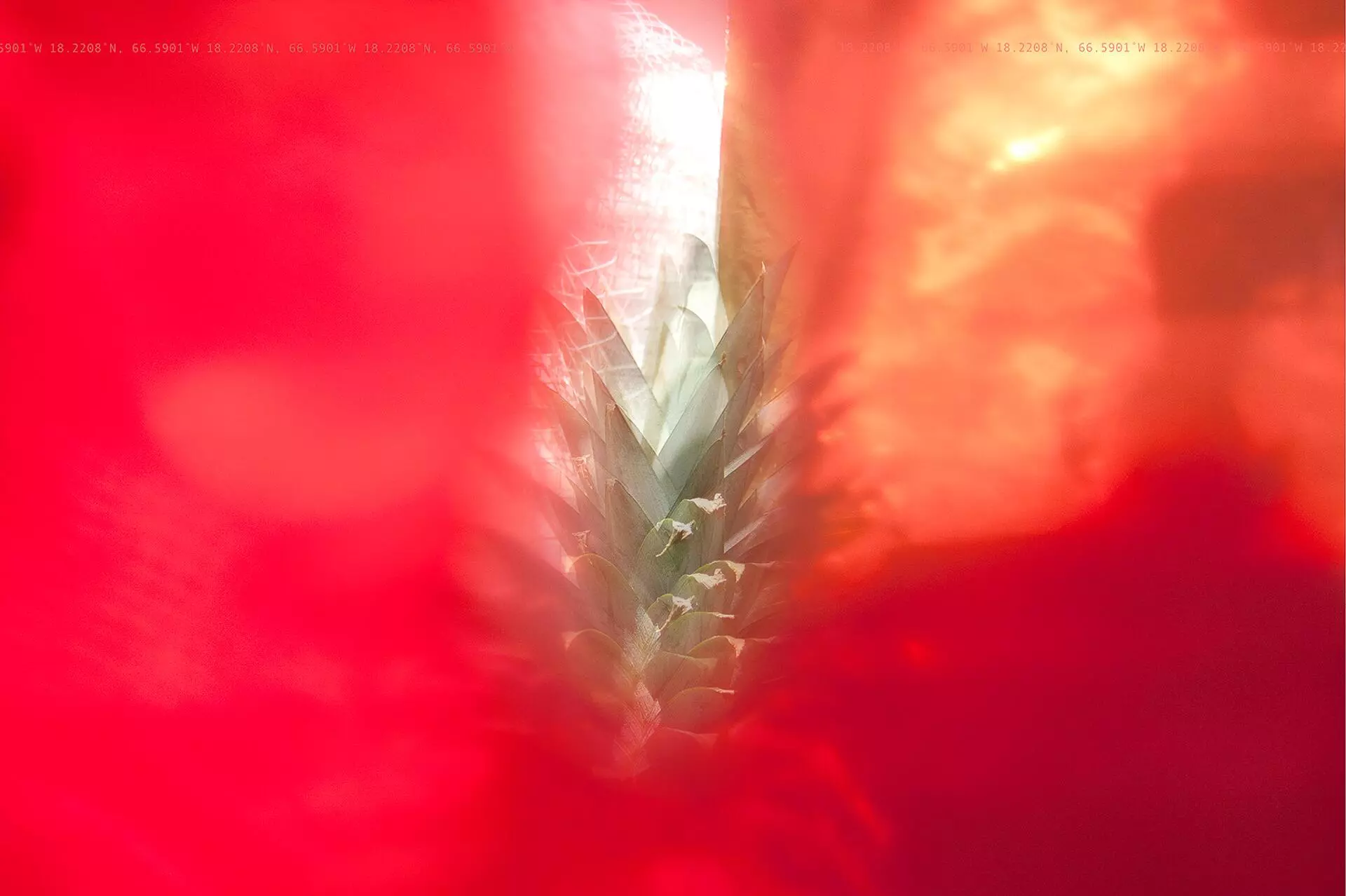
The mourning after the hurricane was prolonged, but from the economic crisis to the environmental crisis, people took to the streets again in the famous Verano del 19 (Summer of ’19) in a kind of collective and social outpouring. It was a series of popular demonstrations of all kinds —on motorbikes, on horseback, in kayaks, doing yoga, chanting slogans, in short, there were no limits to the creativity of the protests— led by artists and musicians, which culminated in the forced resignation of Governor Ricardo Rosselló. The historical moment was marked by the invisibility of party and ideological lines. In the heat of the summer, the country exploded.
I was less than a month pregnant when it happened. I didn’t know it, but a new life was growing inside me. A future, a small inhabitant for the home republic. I remember the unbearable tiredness —a classic symptom of those early months— every time I attended a protest. I remember carrying a sign that read: like a burning flame tree, we blossom in summer. I remember the pleasure of understanding that there are trees that don’t allow their blossoms to come in spring, just as there are countries whose historical processes have their time.
The joy was short-lived. In January of the following year, months before the start of the pandemic that would affect the entire world, Puerto Rico experienced aggressive earthquakes with their epicenter in the southern part of the country. To say ‘it never rains but it pours’ is not a tropical metaphor. It is unbearably literal.
It is easy to romanticize a protest, but it is difficult to understand it in context. Many things have been said about the Summer of ’19 —that it was inconsequential, that we went back to the same old things, that it was worth it because we united as a country, that something changed, especially among young people— but what everyone agrees on is that we haven’t seen anything like it since the beginning of the 21st century. To understand this you have to go back to Vieques.
***
A glow-in-the-dark insect. A type of click beetle that is just over an inch long and has a narrow, flattened body. Here we call him Cucubano, which is what the Taíno people called him. They are barely seen in the city, just as the lights of all the shades of green in the Caribbean are barely visible. It is a marvelous insect (as almost everything tiny is) which during the day remains hidden in the ground or among plants and at night flies around giving off a luminosity that, like fireflies, is emitted from the end of its body. Puerto Rico has a native species, Pyrophorus luminosus, which, unlike fireflies, also emits light from its head and around the shoulder area, as if it had two bulbs. Moreover, they don’t flash, they glow. Its bioluminescence is an essential brushstroke of the island’s landscape. The Puerto Rican composer and author of countless salsa classics, Tite Curet Alonso, dedicated a song to this, declaring it the “star of the night, on the mountain and on the plain”.
Everything can be found in music. There is another song entitled Verde luz by singer-songwriter Antonio Cabán Vale (“El Topo”) whose lyrics and tune encapsulate a moment in culture and history, but above all in the landscape. For many people here the song is treated like an anthem, it’s one of those things we all agree on. At one point the lyrics are, “my island, captive flower, for you I want to have, your soil free, your star solitary.
Its composer belongs to the generation of Puerto Rican protest songs that formed part of the same movement in Latin America, an artistic and activist space where singing to the land and to the homeland became not only the same song, but the same process of musical revolution. Causes punished with an iron fist by the state found their escape through these melodies and lyrics.
In Puerto Rico, as in Latin America, this artistic space loudly demanded the defense of natural resources, always under siege by the same interests that besiege them around the world: the exploitation of the earth, thinking in the present that is incapable of imagining its ephemeral nature. A shot in the foot, no more. But it also had a particularity that gave it an identity of its own: the struggle for the country’s independence.
We must remember —even if it is exhausting— that Puerto Rico is a late colony of the United States. Even the deniers of this assertion today admit it and acknowledge it, with or without shame. It is an unincorporated territory, it is foreign in a domestic sense, it belongs to but is not part of the United States and its political status is defined as the Commonwealth of Puerto Rico in English, and in Spanish it was called the Estado Libre Asociado (the name is an inefficient, incorrect and not at all literal translation, given that the term mancomunidad exists in Spanish). It would not be an exaggeration to say that it is none of the three things in their totality, nor to recognize that its political status has not prevented the development of a full national consciousness and identity on the island. In fact, Puerto Rican issues are discussed within the United States House Committee on Natural Resources. As in any colonial relationship, the citizens that occupy the colony are just another natural resource that deserve no further distinction.
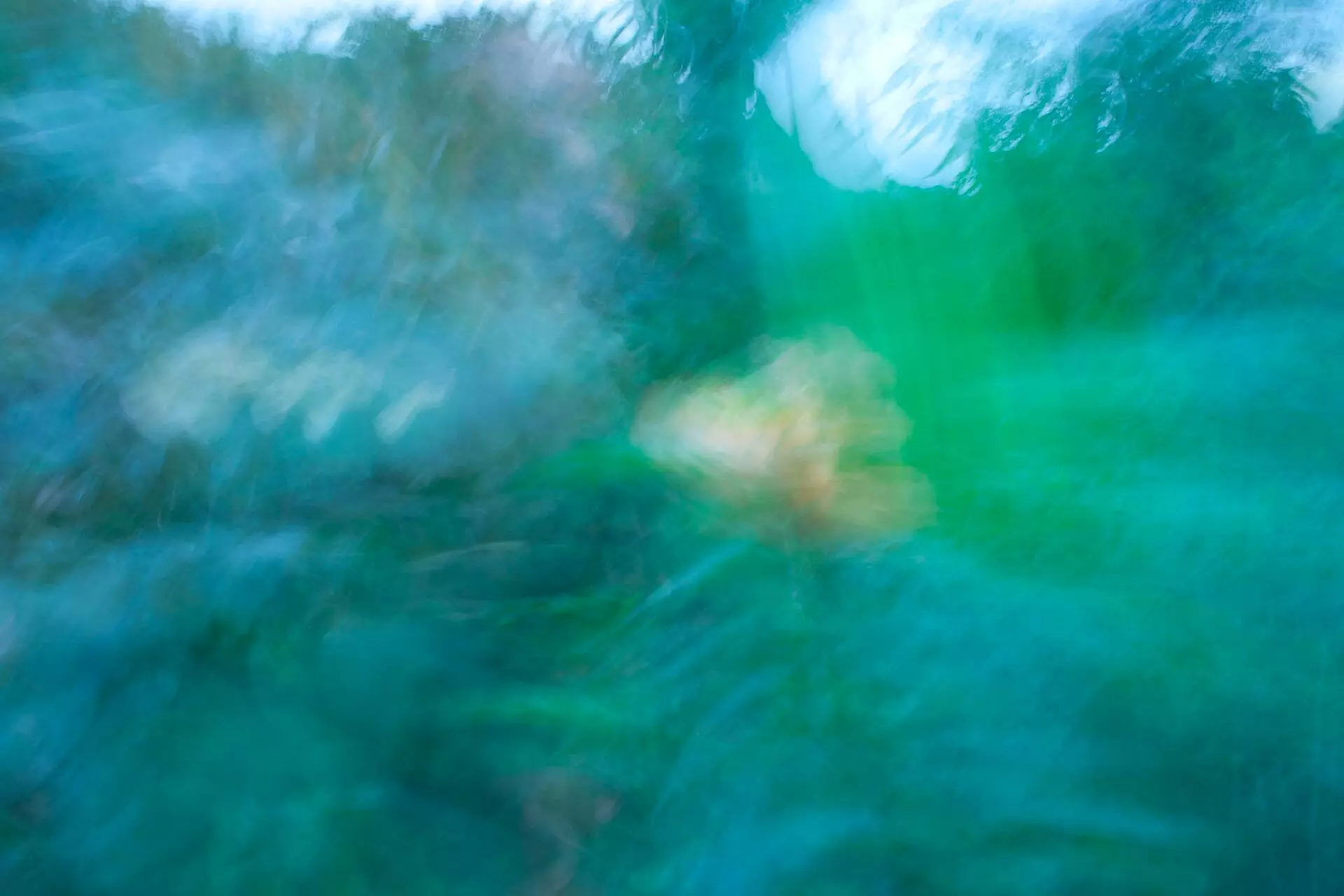
Vieques resisted —as at so many other times in history— this unequal and politically subordinate relationship. In 2003, the US Navy was forced to abandon the land it occupied on the island municipality of Vieques, which it used for military practices and maneuvers that, to this day, have had harmful effects on the life and health of the island’s inhabitants, who, among other ailments, face one of the highest incidences of cancer in the country. Military practices require a range of munitions that expose the island’s inhabitants to pollutants that have made it a hotspot for lung cancer. For example, in 2017 the Department of Environmental Sciences at Aarhus University in Denmark —and published by Global Security: Health, Science, and Policy— found that during the 1990s the prevalence of this particular cancer in people over 50 was higher than in the rest of the country. The percentage is staggering: 280% higher in women and 200% in men. On the other hand, a similar study issued by the Federal Agency for Toxic Substances and Disease Registry determined years earlier, in 2013, that there was no relationship between military practices and the health of the people of Vieques. Testimonies and the way in which art has reacted to history balance out the confusion. Just take a look at filmmaker Glorimar Marrero’s film La Pecera, the story of a Vieques woman facing cancer, life and returning home.
The Navy’s departure followed decades of organized activism, land occupations and constant acts of civil disobedience that gained momentum after the death of a civilian security guard named David Sanes Rodríguez from aerial bombing by a US Marine Corps F-18 jet. The occupation dates back to the 1940s and it was under the leadership of the Puerto Rican Independence Party, then presided over by Rubén Berríos Martínez, who ran a civil disobedience camp on the land, and together with a multisectoral alliance of civil, labor, religious and political organizations and all the social diversity of the country, succeeded in expelling the Navy, considered the most powerful in the world. The defense of land and humanity was naturally tied to the political notion of freedom, in the case of Puerto Rico: independence as a political destiny.
It is worth noting that not everyone who has supported causes like this one believes that this is the best destiny for the country. Some people believe it should be annexed as a state to the United States and others who insist on the exploration of other autonomous models under arrangements that would grow out of the current status. There have even been environmental activists who feel it is more important to defend the earth under our fingernails than the land we hold in our memory.
“If we do not harmonize our existence with strong conservation measures and fight to change the current model of environmental exploitation; if we do not build a sustainable future by addressing poverty and inequalities, colony, statehood or independence will be meaningless destinies,” warns Arturo Massol Deyá, a Puerto Rican microbiologist and activist who has to his credit a multitude of environmental and political victories from Casa Pueblo in Adjuntas, an organization founded by his parents which, among multiple victories led a fight against the construction of a gas pipeline, battled in the south against the management of ashes by a private company, and has achieved the unthinkable for many, proving to the people that “those who produce their own energy can govern themselves”, as he says in his book Ciencia para la insurgencia [Science for Insurgency]. The text not only details various environmental battles, in defense of drinking water, agricultural land and above all the generation of solar power, but citizens have been able to experience first-hand what independence can mean on a small scale —the home, a business, an entire community— in order to imagine it on a large scale.
There are detractors of this position and their argument is fundamental to understanding the Puerto Rican case. After all, is it possible to care for, to protect, to save the land while it is still under occupation? Is it possible to create an environmental policy and implement it under the current political order? Can existing projects that work in defense of clean water, in response to lack of food sovereignty, on energy issues, air quality, projects that obtain permits or are built in maritime or protected areas without the safeguard of a state of their own with final and firm authority, truly grow and be implemented on a large scale? Can a forward-looking society and economy be forged in a place where there is no guarantee that the electricity system will work in the next few hours, or overcome a climate shock?
This is what the Puerto Rican case is all about, hence the gradients of every shade of green. This is one of the challenges of living amongst so much beauty and so much light – day or night, sea or tropical forest: the beauty is blinding, it distracts, and one fine day in the midst of the rapture, the lights go out.
***
Ana Teresa Toro is a journalist and a writer. She is the author of the novel Cartas al agua and the reportage books Las narices de los perros and El cuerpo de la abuela. In 2019 she published a book in the form of an interview with former governor of Puerto Rico, Alejandro García Padilla (Vida, Patria y Verdad), as well as a book about the history of Taller Salud, the oldest working feminist organization in Puerto Rico (Un cuerpo propio: 40 años de Taller Salud) and co-authored the book Somos más: crónicas del Verano del 19. In 2020 she published, together with writer Edmaris Carazo, the book Parir es partirse, a collection of reportage and essays about motherhood.
This story is part of the Colapso project by Dromómanos, an independent news producer based in Mexico.
About Dromómanos
Dromómanos is a producer of independent journalism that investigates, educates and experiments to tell the story of Latin America in collaboration with journalists from all over the region. The project began in 2011, when its founders Alejandra S. Inzunza and José Luis Pardo Veiras traveled across the continent in a third-hand Volkswagen Pointer in a bid to forge a new journalistic model of continental coverage. Together they have created more than 20-long form reportages and Narcoamérica, a book documenting the impact of drug trafficking on everyday life in societies throughout Latin America. In the past 12 years, Dromómanos has worked with over 100 contributors and partnered with 60 national and international media outlets to address the most pressing issues for Latin Americans, such as violence, the climate crisis, authoritarianism, migration and corruption.
About the Colapso project
What happens when the power of nature intersects with human suffering? In few places can one find a more striking answer to this question about our present and future than in Latin America, the most disparate and one of the most biodiverse regions in the world. Colapso ventures deep into the jungles, mountains, islands, forests, deserts, oceans and cities of the region, to report from the field on the symptoms and consequences of the climate crisis.
Text: Ana Teresa Toro
Photos: Tari Beroszi
Fact check: Dromómanos
Spell check (portuguese): Valquiria Della Pozza
Translation into portuguese: Paulo Migliacci
English translation: Charlotte Coombe
Visual editing and page setup: Viviane Zandonadi, Lela Beltrão, and Érica Saboya
Director: Eliane Brum
